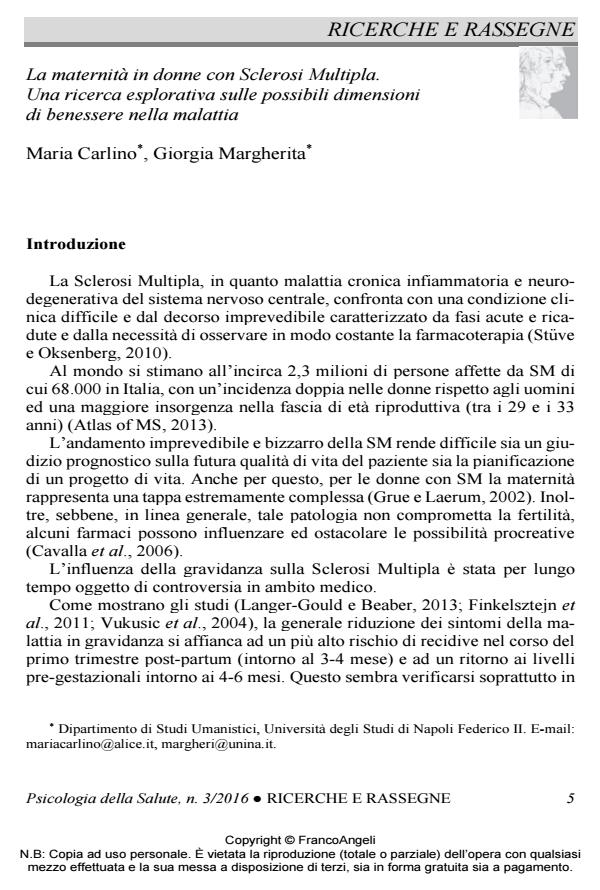La maternità in donne con Sclerosi Multipla. Una ricerca esplorativa sulle possibili dimensioni di benessere nella malattia
Titolo Rivista PSICOLOGIA DELLA SALUTE
Autori/Curatori Maria Carlino, Giorgia Margherita
Anno di pubblicazione 2016 Fascicolo 2016/3
Lingua Italiano Numero pagine 21 P. 5-25 Dimensione file 315 KB
DOI 10.3280/PDS2016-003001
Il DOI è il codice a barre della proprietà intellettuale: per saperne di più
clicca qui
Qui sotto puoi vedere in anteprima la prima pagina di questo articolo.
Se questo articolo ti interessa, lo puoi acquistare (e scaricare in formato pdf) seguendo le facili indicazioni per acquistare il download credit. Acquista Download Credits per scaricare questo Articolo in formato PDF

FrancoAngeli è membro della Publishers International Linking Association, Inc (PILA)associazione indipendente e non profit per facilitare (attraverso i servizi tecnologici implementati da CrossRef.org) l’accesso degli studiosi ai contenuti digitali nelle pubblicazioni professionali e scientifiche
Per le donne con Sclerosi Multipla la maternità rappresenta una tappa estremamente complessa. Il lavoro si propone di esplorare i significati che maternità e malattia assumono per le donne con SM a partire dall’idea che gli aspetti rappresentazionali possano influenzare orientamenti, progetti e scelte. Metodi. Lo studio ha coinvolto 20 donne con Sclerosi Multipla alle quali è stata somministrata un’intervista. I testi delle interviste sono stati analizzati con un’analisi dei cluster mediante il software T-Lab (Lancia, 2004). Risultati. Sono emersi quattro cluster tematici denominati: il ruolo familiare, il dolore del quotidiano, dipendenza dall’area medica, chiudere il cerchio. Tali risultati, interpretati su piano fattoriale, organizzano tre vettori di senso rappresentativi delle dinamiche: dal concreto all’astratto, dal progetto alla ricaduta, dai Servizi di supporto al supporto della famiglia, che evidenziano uno spazio rappresentazionale dove è difficile tenere insieme malattia e maternità. Conclusioni. È stato possibile osservare come alcune dimensioni (l’essere in coppia e conoscere la diagnosi da un maggior tempo) possano configurarsi come fattori di sostegno specifico alla scelta di maternità. Emergono spunti di riflessione sulla necessità di progettare, nei Servizi di cura, interventi permanenti, che integrino aspetti psicologici negli abituali percorsi terapeutici.
Parole chiave:Sclerosi Multipla, maternità, rappresentazioni
- Teen mothers who are daughters of teen mothers: Psychological intergenerational dimensions of early motherhood Giorgia Margherita, Gina Troisi, Francesca Tessitore, Anna Gargiulo, in Children and Youth Services Review /2017 pp.294
DOI: 10.1016/j.childyouth.2017.10.010 - Illness representation in patients with multiple sclerosis: A preliminary narrative medicine study T Paolucci, M Reho, C Ciacchella, G Veneziani, I Santoro, G Fiorentino, F Galli, C Lai, in Multiple Sclerosis Journal - Experimental, Translational and Clinical 20552173241271755/2024
DOI: 10.1177/20552173241271755 - Female Nigerian asylum seekers in Italy: An exploration of gender identity dimensions through an interpretative phenomenological analysis Francesca Tessitore, Giorgia Margherita, in Health Care for Women International /2021 pp.165
DOI: 10.1080/07399332.2019.1692849 - Underfifty Women and Breast Cancer: Narrative Markers of Meaning-Making in Traumatic Experience Maria Luisa Martino, Daniela Lemmo, Anna Gargiulo, Daniela Barberio, Valentina Abate, Franca Avino, Raffaele Tortoriello, in Frontiers in Psychology 618/2019
DOI: 10.3389/fpsyg.2019.00618 - Italian Validation of the Capacity to Love Inventory: Preliminary Results Giorgia Margherita, Anna Gargiulo, Gina Troisi, Francesca Tessitore, Nestor D. Kapusta, in Frontiers in Psychology 1434/2018
DOI: 10.3389/fpsyg.2018.01434
Maria Carlino, Giorgia Margherita, La maternità in donne con Sclerosi Multipla. Una ricerca esplorativa sulle possibili dimensioni di benessere nella malattia in "PSICOLOGIA DELLA SALUTE" 3/2016, pp 5-25, DOI: 10.3280/PDS2016-003001